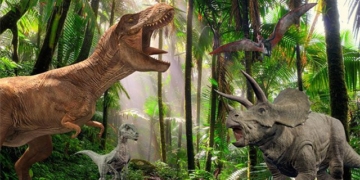What is particularly interesting is how a flood-prone region with little to no natural resources like the Netherlands has become a global agricultural, technological, and business hub today.
Second Largest Agricultural Exporter in the World
More than half of the land in the Netherlands is used for agriculture. Each year, the Netherlands produces 4 million cattle, 13 million pigs, and 104 million chickens, supplying vegetables to a large part of Western Europe. The country has nearly 24,000 acres of greenhouses. These greenhouses use less fertilizer and water but can yield products equivalent to 10 acres of traditional farming. To grow 0.45 kg of tomatoes, Dutch farms only use half a gallon of water, while the global average is over 28 gallons.

Dutch vegetable greenhouse. (Image: Internet).
The Dutch often say that they focus solely on food production. This stems largely from the severe famine the country experienced during World War II. However, the concern for food began in the 17th century when the Dutch became a center of the global spice trade. Currently, 15 of the 20 largest agricultural companies in the world have significant research and development centers in the Netherlands; the top 5 food and agricultural companies are headquartered in the Netherlands.
With groundbreaking innovations, the Dutch are renowned for their advancements in agriculture. The Netherlands is the largest exporter of meat in the European Union, and in 2020, it exported pork, beef, and poultry worth 8.8 billion euros (approximately 9 billion USD), primarily to Germany (beef, veal), the UK (poultry), and China (pork).
In 2023, Dutch agricultural exports totaled 123.8 billion euros, an increase of 1.6% compared to 2022, generating 50.4 billion euros from agricultural product exports (up 4% from 2022). Of this total, 45.7 billion euros came from agricultural products produced in the Netherlands, and 4.7 billion euros from re-exporting agricultural products produced elsewhere.
Among the top exported agricultural products from the Netherlands, the three leading items remained unchanged from 2022: dairy and eggs; agricultural products; and meat. There was hardly any change in the export value of dairy and eggs (12.0 billion euros) or fruit and vegetable exports (11.5 billion euros) from 2022 to 2023; meat exports increased by 2% from 11.0 billion to 11.2 billion euros. At the end of the list, vegetable exports rose by 12%, fruit by 11%, and processed and preserved vegetables by 14%.
Addressing Climate Change
The growth of Dutch agricultural exports has sustained its momentum for many years, partly due to tripling research and development (R&D) funding over the past three decades (around 2% of GDP), focusing on increasing productivity while reducing reliance on energy, water, and inputs (greenhouses have nearly eliminated pesticide use).
In 2022 alone, total spending on R&D and innovation in the Netherlands amounted to approximately 9.9 billion euros. Three examples illustrate how this country’s agriculture is becoming more sustainable. Wageningen University has grown the first locally cultivated Dutch bananas using a substitute soil mix made from coconut peat and rock wool. This process ensures that no fungi infiltrate the product through poor soil and generally creates an efficient banana cultivation process.
The Dutch company Nijsen/Granico produces about 90,000 tons of animal feed each year entirely from human food waste, thus creating a much more sustainable meat production cycle. The entire “floating farm” in Rotterdam feeds cows with leftover food from local restaurants, collected by electric trucks from GroenCollect. Cow manure is also collected and sold, making the floating farm quite sustainable.
It is no surprise that agriculture is one of the sectors most affected by global emissions and climate change. Since the beginning of this century, many farmers have reduced their water dependency for key crops by up to 90%. Dutch farmers have also nearly eliminated the use of chemical pesticides in greenhouses.
However, feeding 8 billion people and combating climate change by 2050 still requires significant efforts. The Dutch have pioneered in cell cultivation, vertical farming, seed technology, and robotic milking and harvesting – leading innovations focused on reducing water use as well as minimizing carbon and methane emissions.
The Dutch are also increasingly aware of the climate impact on agricultural exports. This is one of the factors that has brought many exciting agricultural innovations from the Netherlands into the spotlight. With limited land and a rainy climate, the Dutch have become masters of efficiency.
Nevertheless, challenges remain as the greenhouse industry thrives partly due to cheap energy, while Western Europe is currently facing rising gas prices. Additionally, the intensive livestock farming practices in the Netherlands are also at risk. The conservative government coalition has committed to halving nitrogen emissions by 2030, which will require a significant reduction in the number of animals raised in the Netherlands.



















































